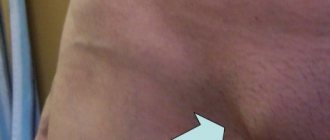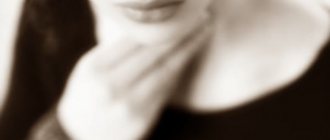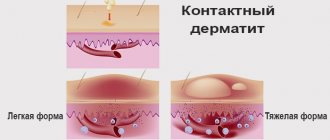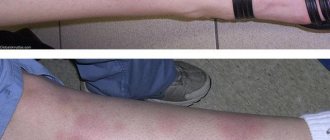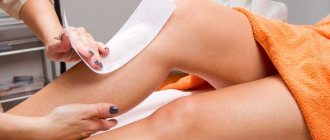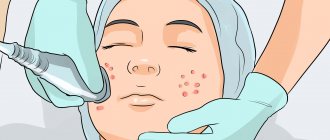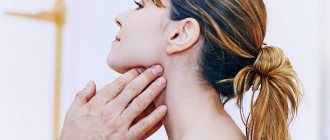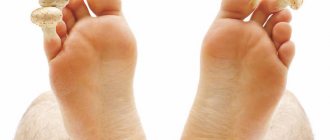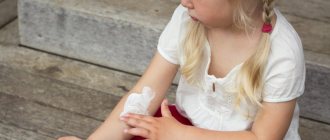Athlete's groin is a fungal skin disease that most often occurs in the groin. Men are most susceptible to this disease. The disease manifests itself in the form of pink spots up to 1 cm in size. The spots itch, thereby causing discomfort in the patient. If you do not begin to treat inguinal athlete's foot in time, it can last for several years.
To prevent the disease, you should follow the rules of hygiene in public showers and baths, use personal hygiene products, and wash several times a day. If you follow these simple steps, you will not face any disease.
Causes of inguinal athlete's foot
The causative agent of the infection is the opportunistic flocculent fungus Epidermophyton floccosum (epidermophyton). When it gets on the skin, it settles in the upper layers of the epidermis, in its scales, destroys and utilizes collagen, so the affected areas quickly lose their elasticity.
You can become infected with it through household items, visiting gyms, public baths, saunas, swimming pools, using other people's bath accessories or shared rugs, bedding, basins, benches, everything that is abundantly contaminated with the fungus. If a sick person appears in the house, he can infect all his relatives living with him under the same roof. Flake fungi are highly resistant to the environment; their activity increases in conditions of high temperature and high humidity.
Causes and risk of developing the disease
Among a fairly large number of very different reasons that cause the appearance of inguinal athlete's foot in men, two main groups can be distinguished: objective factors and subjective.
The first group includes the following:
- increased air humidity;
- high ambient temperature.
Expert opinion
Sakania Luiza Ruslanovna
Dermatovenerologist, cosmetologist, trichologist
Ask a Question
From which it follows that the disease is more widespread in those countries where hot weather with high air humidity prevails. This causes profuse sweating and provokes the occurrence of various types of fungal skin infections.
Subjective factors include:
- increased sweating;
- presence of damage to the skin;
- various disorders in the body's endocrine system, including diabetes;
- obesity, which makes it difficult to carefully care for the skin in certain parts of the body;
- flat feet;
- neglect of the rules of basic hygiene.
The risk group includes men:
- visiting public places with high temperature and humidity (baths, swimming pools, showers, beaches);
- who are in direct contact with an infected person;
- using patient items without disinfecting them.
Provoking factors
For the development of an infection, it is not enough just for the spores of a pathogenic microorganism to come into contact with the skin. The skin is a reliable protective barrier that flocculent fungi cannot overcome.
Athlete's foot can occur only when the integrity of the skin is damaged. This is possible when wearing tight clothing that creates strong friction or pressure, when sweat becomes alkalized, as well as when microcirculation in the epidermis and dermis is disrupted. A long stay in a hot, humid climate, exposure to intense training, and a history of certain diseases that can change the acidity level of sweat (diabetes mellitus, vitamin deficiency) are considered dangerous. There are other triggers too.
The likelihood of damage increases if a person has:
- fungal diseases of the feet and hands,
- obesity, which results in the formation of deep folds on the body,
- damage to the skin (abrasions, scratches, cracks),
- excessive sweating,
- diaper rash caused by neglect of personal hygiene rules,
- low immunity,
- diseases associated with disruption of the endocrine system.
The presence of one or several of the listed factors creates favorable conditions for the proliferation of fungi.
Symptoms
Skin rash is the main symptom of athlete's foot. Predominant localization of rashes: groin area and inner thighs. The fungus may spread to the skin of the external genitalia, the area around the anus, and the perineum. In rare cases, the disease affects the spaces between the toes and toenails.
An example of a skin rash due to athlete's foot
Characteristics of skin rash:
- pink spots from 1 to 5 cm in diameter;
- pronounced peeling in the area where the spots spread;
- severe itching.
The rash gradually grows along the periphery with simultaneous resolution of the process in the center. At the height of the disease, large, up to 10 cm in diameter, pink flaky rings with jagged edges can be seen on the skin. The boundaries of the inflammatory foci are clearly delineated. Along the edge of the spots there is a bright red ridge with small transparent bubbles on its surface. The blisters are never located in the center of the spot, which is a hallmark of athlete's foot inguinal.
The disease caused by Trichophyton mentagrophytes is characterized by a rapid course with rapid resolution of the pathological process and recovery. Inguinal athlete's foot, caused by Epidermophyton floccosum and Trichophyton rubrum, develops gradually and lasts for quite a long time.
Without adequate therapy, the disease can last for years with alternating periods of exacerbation and remission (recovery).
Symptoms and signs of athlete's foot
Fungal infection has characteristic symptoms and a gradual development of clinical manifestations.
- First, small inflamed spots (up to one centimeter) appear on the skin, the surface of which flakes and itches slightly.
- Gradually, the affected areas increase in size, merge with each other and form oval fields with a diameter of up to 10 cm.
- A rash forms inside them, its elements are vesicles and pustules filled with liquid.
- When the rashes open, weeping eczema is formed, which gradually becomes covered with crusts. This phenomenon causes increased itching.
- In the central part of the field, over time, the inflammatory process weakens, the skin turns pale and sinks, and at the edges, when the swelling goes down, a roll of exfoliating epidermis forms.
- Walking causes severe discomfort. Humidity and heat increase the severity of itching.
The entire process of infection development takes place in several stages.
Diagnosis of athlete's foot
The disease is easily suspected by the characteristic places where the infection settles and by the changes in the skin that it causes.
But still, an accurate diagnosis cannot be made “by eye”.
A number of diseases have similar manifestations, and it is sometimes difficult to distinguish epidermophytosis from them:
- candidiasis of large folds - including diaper dermatitis
- erythrasma
- eczema, including seborrheic
- rubromycosis
- contact dermatitis
In addition to the usual examination, examination under the light of a Wood's lamp helps to make a diagnosis. It produces light close to the ultraviolet spectrum. In the rays of the device, fungal lesions have a greenish tint.
Laboratory diagnostic methods help clarify the diagnosis:
- scraping microscopy - examination under a microscope of scrapings from the affected area;
- cultural (bacteriological) inoculation on the medium.
Scraping microscopy is a cheap and fast method of additional diagnostics. Before placing the material under a microscope, it is treated with a solution of potassium hydroxide (it dissolves epithelial scales) and a special dye.
Expert opinion
Sakania Luiza Ruslanovna
Dermatovenerologist, cosmetologist, trichologist
Ask a Question
When examining such a scraping, a laboratory technician can easily detect the fungus and determine whether it belongs specifically to dermatophyte fungi - a group of fungi that live in the epidermis. True, in this way it is impossible to determine which type of fungus - epidermophyton or another from this group - is to blame for the disease.
However, most often there is no real need to accurately determine the type of fungus - because almost the same treatment is prescribed for the entire group of dermatophytes. In some doubtful cases, the cultural method is also used - when the scraping material is placed on a nutrient medium and microorganisms are grown in it.
When they multiply, it will be possible to clearly determine what kind of infection the patient has. However, such an analysis is not always necessary. The cultural method is quite expensive, and the result of the research will be ready no earlier than in 1-2 weeks.
Meanwhile, for effective treatment it is enough to simply establish that the pathogen is a dermatophyte fungus - therefore microscopy of a stained smear is usually sufficient.
Stages of the disease
From the moment of infection to the appearance of the first clinical manifestations, little time passes; a fungal infection always develops rapidly and goes through the following stages in its development:
- Initial. The pathogen is introduced into the upper layers of the epidermis and actively reproduces.
- Spicy. The formation of new colonies of fungi develops, symptoms of skin lesions appear, and weeping areas form. The process ends with the formation of fading fields (the central part of the spots turns pale, rings with itchy red edges form).
- Chronic. The disease becomes protracted and always flares up in waves (remissions are replaced by exacerbations). The spots do not disappear completely; they become inflamed with renewed vigor each time in men and women when body temperature rises in the affected area and high humidity forms. Repeated exacerbations occur with less severe symptoms and quickly stop.
- Launched. It is formed when choosing the wrong treatment or ignoring an existing problem. As a result, large blisters appear on the skin of the affected areas. Their accidental damage leads to the development of weeping eczema. Its presence in the designated areas is fraught with bacterial infection and dangerous complications. To prevent them, you must immediately seek medical help.
The earlier a problem is identified, the easier it is to get rid of it.
How does infection occur?
The definition of epidermophytosis goes by several additional names:
- ringworm; ringworm;
- dermatophytosis.
The disease spreads only to smooth human skin. The causative agent of fungal infection is fungi of the genus e. floccosum, m. Rubrum, causing inguinal skin lesions.
Mycoses of this genus are found everywhere in the environment - on surfaces, on household items. Human infection occurs under conditions favorable for the proliferation of mycosis.
These conditions include:
- environmental humidity;
- warm.
Places and methods of infection with epidermophytosis:
- swimming pools, saunas, shower rooms for public use;
- specific professional conditions - kitchen workers, bakeries, hot shops;
- neglect of personal hygiene, use of other people's personal belongings, linen and bedding.
There may be other variants of infection, but they are united by the same factors:
- presence of heat,
- friction,
- high humidity.
Mycosis of smooth skin does not have a sex-selective pattern of infection, however, in practice, the majority of infected people are male.
Inguinal athlete's foot in men usually occurs with damage to the inner surface of the thighs and the intergluteal fold.
Most likely, the following factors may be the reason for this:
- increased sweating;
- greater physical activity than women;
- natural increased vegetation in the groin area;
- insufficient personal hygiene.
The disease is easily transmitted from an infected person through personal hygiene items and close contact.
Infectious lesions in humans usually occur in two forms:
- In the form of damage to the groin area.
- Damage to the feet and interdigital space.
With skin lesions of the groin area, infection is observed in the following areas:
- between the groin and inner thigh;
- between the gluteal folds;
- diaper rash under the mammary glands;
- axillary area.
Inguinal athlete's foot in women can manifest itself as damage to the folds of skin under the breasts.
Differential diagnosis
If you notice symptoms of inguinal athlete's foot, you must consult a dermatologist to confirm the diagnosis. At the first appointment, the specialist listens to the patient’s complaints, carefully collects anamnesis, examines the affected areas and scrapes them. Microscopy makes it possible to determine the presence of spores, which are grouped in rectangular chains, and actively branching septate mycelium. To identify the fungus, bacteriological seeding is carried out in cultural media. After a week, colonies of fungi grow in them, having a round shape, yellow color and fluffy consistency.
It is necessary to differentiate inguinal athlete's foot from psoriasis, rubromycosis and different types of dermatosis.
Symptoms: rash, burning and itching
Inguinal athlete's foot in men has pronounced clinical symptoms. Red, scaly spots appear in the groin folds or on the inner thighs. In the center they are almost no different from healthy skin, but at the edges they are red or red-pink. This is how the initial stage of the disease manifests itself.
Gradually the number of spots increases, they merge with each other. The meeting point of the spots is called the focus. It is in the foci that scales (which, falling off, are visualized as peeling), blisters and pustules are localized. All this causes burning and itching.
The contour of epidermophytosis is characterized by wavy edges (in dermatology they are called the beautiful word “scalloped”) and an elevation above healthy skin. In appearance, the roller-shaped outline resembles a red worm curled into a ring at the site of the pathology. In medicine, this symptom is called a more euphonious phrase - “cord symptom.”
Drug therapy
To combat fungal infection, complex therapy is used.
The patient is prescribed:
- Antifungal ointments (Mikoseptin, Econazole, Ciclopirox).
- Anti-inflammatory drugs (silver nitrate solution or Triderm ointment).
- Antihistamines (Tavegil, Zyrtek, Suprastin).
Inguinal athlete's foot should be treated for a long time, daily, twice a day, by treating the affected skin with the listed ointments. The presence of a fungal infection requires adjustments to the functioning of the immune system. To strengthen it, immunostimulants (Imunorix, Immunal) are used. If a bacterial component is added to the course of the disease, antibiotics are included in the drug treatment regimen.
Active growth of skin lesions requires hospitalization of the patient. Intensive treatment of inguinal athlete's foot is carried out through desensitization, etiotropic therapy and autohemotherapy. The patient is prescribed a course of antibiotics and vitamins.
Treatment and diagnosis
If such spots are present, you should contact a medical specialist. The diagnosis is made on the basis of a physical examination and study of the nature of the rashes and their localization. Also, to clarify the diagnosis, the doctor interviews the patient about the course of the disease in order to establish the characteristic stages of the fungal infection.
To confirm the diagnosis, a scraping from the affected area is required. Biological material is studied in laboratory conditions under a microscope. Against the background of inguinal athlete's foot, the laboratory technician discovers threads of fungi, which allows us to confirm the previously assumed diagnosis. Sometimes the scraping does not provide the necessary information if it was taken from a wet area. In this case, treatment of inguinal athlete's foot is prescribed based on a visual examination, since other diagnostic procedures are not provided.
Since the source of fungal infection is various things and objects that have been touched by a sick person, simultaneously with the start of treatment it is necessary to carry out disinfectant cleaning in the living room. To do this, wipe all items with a solution of vinegar (1 tablespoon per liter of water). Linen is washed at a temperature of 90 degrees.
Treatment of inguinal athlete's foot in the stronger sex is carried out in stages. At the first stage, it is necessary to stop inflammation, neutralize itching and get rid of weeping. When the required therapeutic effect has been achieved, treatment with antifungal drugs is carried out. They are the main therapy. When there are no inflammatory elements on the patient’s skin, treatment begins immediately from the second stage.
Important: anti-inflammatory and antifungal medications are prescribed for external use - ointments, gels, creams, balms. Oral tablets are rarely prescribed, only when the process is advanced. The use of antibiotics is advisable against the background of pustular lesions of the skin.
The following medications are prescribed for therapy:
Appointment with a urologist: preparation for examination, diagnosis and treatment measures
- First stage. Treatment of the affected area with Miramistin, 0.25% silver solution, 1-2% resorcinol solution. When the inflammatory process is so strong that a man cannot move or do normal activities, the use of creams based on hormonal substances (Hydrocortisone) is recommended. Hormonal drugs are used in courses, the maximum duration of therapy is 7 days. If there are blisters, they are pierced with a sterile needle and the exudate is released. Compresses with anti-inflammatory solutions are made 2 times a day, secured with a bandage.
- Second phase. Use a solution of Fukortsin, salicylic and zinc ointments, and a two percent tincture of iodine. As an alternative, Ketoconazole and Terbinafine are prescribed. Antifungal medications are applied twice a day. Treatment continues until all symptoms disappear. The average duration of therapy is 5 weeks.
If a man is bothered by severe itching, then the use of antihistamines in tablet form is recommended. They help relieve itching, reduce the severity of inflammatory processes, and eliminate allergic reactions that have developed due to the activity of fungal microflora. Suprastin, Zodak, Cetrin are prescribed. When a secondary bacterial infection is diagnosed, antibacterial treatment with drugs is required: Imipenem, Cephalexin.
Traditional medicine recipes
To speed up recovery, it is important to wash daily and take baths with medicinal infusions that have anti-inflammatory and antiseptic effects. To prepare them, you can use St. John's wort or chamomile, oak bark or birch leaves.
After completion of the acute phase, the following traditional medicine helps to prolong the effect of drug therapy:
- Essential oils prepared from eucalyptus leaves, fir needles, black poplar. They have antifungal properties, therefore, to prevent exacerbation, experts recommend daily treating the skin areas that were involved in the pathological process with them. To do this, they need to be diluted with any vegetable oil.
- Alcohol tinctures prepared from poplar or birch buds, calendula flowers. Taking drops orally relieves inflammation well.
- Herbal decoctions prepared from chamomile, yarrow, oak bark, calendula flowers and juniper berries also help relieve inflammation, relieve itching and reduce fungal activity. Decoctions are taken orally, 50 grams three times a day.
If for some reason you cannot take antihistamines during an exacerbation (during pregnancy, for example), you can relieve itching with celandine juice diluted in equal proportions with vegetable oil.
Features of the course of the disease in children
Athlete's foot in children is extremely rare. Infection occurs through contact with carriers of a fungal infection - sick family members or pets. The disease in childhood occurs in an acute form, the clinical picture is different.
Symptoms of athlete's foot in children:
- increase in body temperature to 39-40 degrees;
- erythema of the skin in the interdigital fold;
- erythrasma in the groin;
- itching;
- erosive processes;
- formation of seropapules;
- lymphadenitis.
When a bacterial infection occurs, suppuration is observed and the intoxication syndrome intensifies. Treatment of the disease in children is carried out in a hospital setting under the supervision of a doctor.
Methods of prevention and prognosis
Knowing the causes of inguinal athlete's foot, it is not difficult to understand what to do in order to prevent infection. Important:
- Have personal bath accessories and use only them. Never give your washcloths, towels, linens, bathrobes, or shoes to strangers.
- Constantly fight excessive sweating.
- Carefully care for the folds of the body, after bathing, wipe them with salicylic alcohol, and then treat them with baby powder.
- Do not walk barefoot in public saunas, swimming pools, baths.
- In hot weather, wear clothes made from natural fabrics.
- Practice stress prevention.
- Strengthen immunity.
If you discover the first signs of the disease, you should not self-medicate: the fields of fungal infection rapidly increase in size, the acute phase quickly turns into a chronic form. Only timely consultation with a doctor guarantees a quick recovery. Modern antimycotic drugs help to successfully treat even advanced infections, so the prognosis is always favorable.
Prevention
To avoid the development of fungal diseases in the groin area, you need to follow the simplest preventive requirements:
- Avoid direct contact with people sick with fungal diseases.
- Use only your own shoes and clothes, even in public places, such as a bathhouse or sauna, gym, swimming pool.
- Fight hyperhidrosis.
- Monitor compliance with hygiene rules and requirements.
- Use antibacterial and disinfectants to treat skin areas.
- Strengthen immunity.
- Deal with stressful situations.
- Lead a healthy lifestyle.
- Take a shower at least once a day.
- Change linen daily, which should be washed and ironed.
- Use underwear made from natural materials.
- Disinfection of objects and places where there are sick people.
The progression of the disease will lead to irreparable consequences: from the formation of ulcers that will become inflamed and cause a lot of inconvenience to the development of skin cancer. Only through the use of modern medications can a complete cure of epidermophytosis be achieved. And remember that the disease is best treated in its developmental stage.
Symptoms of athlete's foot
There are four forms of the disease, differing in location and symptoms.
- Athlete's nails . In this case, stripes and spots of a rusty-yellow color appear at the free edge of the nail plate. As the disease progresses, the nail turns yellow and thickens. Horny masses accumulate under the plate, and the plate itself breaks and crumbles. Sometimes the nail plate, on the contrary, becomes very thin and then falls off (onycholysis). In both cases discussed, the nails of the first and fifth toes are usually affected.
- The intertriginous form is usually formed against the background of an existing, but not clearly expressed, squamous form. Quite rarely, but it happens that it develops independently. In this case, the interdigital folds are affected, between the fourth and fifth, and much less often, between the third and fourth toes. The disease can also affect the back of the foot. A fungal infection manifests itself in the form of cracks and detachment of the epidermis in these areas. The process can subside in winter and resume in summer, and the damaged stratum corneum provides excellent conditions for the growth of streptococcal infection, which gives possible complications in the form of thrombophlebitis and recurrent erysipelas, which is characterized by itching and pain.
- The dyshidrotic form is characterized by the appearance of groups of bubbles of small diameter. Later, individual vesicles unite and form multi-chambered vesicles, in the place of which, after opening, eroded surfaces with macerated epidermis on the periphery remain. In cases where the disease affects the outer surface of the foot from the side, the formation of a common pathological focus is possible. In this case, the patient constantly feels itching and pain. If a secondary infection occurs, the fluid in the blisters becomes cloudy, and pus is released from them, which indicates the development of lymphadenitis or lymphangitis. When inflammation decreases, erosions heal and the disease takes on a squamous form. However, in situations where the secondary infection is severe, patients often require hospitalization.
- The squamous form is characterized by the appearance of slight peeling and redness on the skin of the arches of the feet. The lesions can be both large and very small. Patients experience mild itching from time to time. This form of the disease is perhaps the most dangerous, since it often develops unnoticed and acts as a source of infection for other people.
How to treat athlete's foot?
As a rule, treatment of athlete's foot does not cause any difficulties. Therefore, you can do it yourself at home. In this case, drugs are used that are sold in all pharmacies and do not require a special prescription. By constantly following the prescribed procedures and taking care of your feet, you can easily get rid of the problem in question.
On the other hand, people with athlete's foot, diabetes, or a severe infection should immediately consult a specialist for advice and adjustment of the course of treatment.
Among the over-the-counter medications prescribed for athlete's foot, the most effective and common are:
- Miconazole (Micatin).
- Tolnaftat (Tinactin).
- Terbinafine (Lamisil).
- Tolnaftat (Tinactin).
Each of these products is local, that is, applied directly to the affected area of the skin. In addition, they are all produced in several forms (gel, cream, ointment, lotion), which allows you to choose the best option in each specific case.
Depending on the degree of damage, therapy lasts from one week to one and a half months. If the patient has developed a vesicular infection, then the feet, in those places where blisters have formed, should be wiped with a special solution a couple of times a day or compresses made from it. This should continue until the fluid leaves the blisters, but not less than 3 days. Next, the antifungal drug prescribed by the doctor is used.
Note that local antifungal drugs are also available only by prescription, but over-the-counter drugs are traditionally prescribed first. In special (severe) situations of the disease, the doctor may prescribe oral antifungal medications, which may be accompanied by side effects. This also needs to be taken into account.
Firmly understand the fact that a full course of therapy will not only save you from an unpleasant disease, but will also prevent its reappearance. Therefore, it is very important to use all prescribed medications for the prescribed time, even if the symptoms of athlete's foot disappear during treatment. It should be said that if you have a fungal infection, it is advisable to refrain from using hydrocortisone cream, unless prescribed by a doctor.
Classification and localization
Depending on the location of the lesion, the skin lesion in question may have slightly different manifestations of the course. Thus, when the feet are affected, the initial manifestations of the disease are noted in the skin between the toes, primarily between the big and middle toes, where a crack forms, which grows in size over time, becomes more and more painful, then blisters and severe redness appear around it. When the skin of the hands is affected, skin hyperemia and an increase in the degree of sensitivity are also noted. However, the appearance of cracks in this area is rarely diagnosed; severe redness and itching of the skin is more often noted.
The disease can also be classified depending on the type of pathology and its symptoms:
- squamous type of epidermophytosis of the skin of the feet and hands, in which erosions and ulcers appear on the affected areas, which can have different locations, shapes and sizes. The coda becomes denser, turns red, and shallow cracks often form. Due to the almost complete absence of cracks in the affected skin, diagnosing this form of pathology is difficult, since the disease begins to develop uncontrollably and rapidly, and its symptoms worsen;
- squamous-hyperkeratotic , when the skin of the foot or hands practically does not peel off, but thickens, its surface becomes covered with small scales of various shapes and sizes. Externally, the affected area becomes similar to an Indian stocking, introducing discomfort into the psychological state of the patient. The rapid aggravation of the development of characteristic symptoms makes this type of disease dangerous; its cure may be delayed if the lesion was detected at a late stage of development;
- The dyshidrotic type of lesion is characterized by the formation of compactions on the skin at the site of the lesion, the skin acquires a red tint, and the peeling process begins, accompanied by severe itching. Blisters with a large number of chambers with transparent mucous contents appear on the affected area in large quantities, after opening which long-term non-healing erosions remain;
- The intertriginous type of the disease is characterized by the formation of a significant number of cracks in the spaces between the fingers, the appearance of blisters, severe burning, itching and soreness of the skin. Cracks heal slowly, the affected areas are marked by the formation of a large amount of dead white skin.
Varieties of epidermophytosis and their characteristic features allow, when diagnosing the disease in question, to immediately begin treatment using the classical scheme, taking into account the characteristics of the patient’s body and the degree of its susceptibility to the therapeutic effect.
Photo of athlete's foot
Photo of fungus in the groin of men
So, now you are familiar with the most popular types of inguinal fungus, which occurs in men of all ages. The photo in the gallery shows examples of characteristic symptoms of athlete's foot, erythrasma and candidiasis of large folds.
Prevention of infection
It is easier to fight inguinal mycosis in the initial stages. Even better is to prevent skin infection.
Strengthen your immune system. Proper nutrition, moderate exercise and getting rid of bad habits will help you with this.
Most often, fungus in the groin in women and men occurs against the background of decreased immunity and insufficient hygiene in the intimate area. To prevent the occurrence of the disease, you need to:
- take a shower or bath daily;
- change underwear 1-2 times a day;
- treat inguinal folds with talcum powder or antifungal powder;
- replace synthetic underwear with products made from natural materials;
- use only individual hygiene items - towels, brushes, washcloths;
- include foods high in microelements and vitamins in your diet;
- use rubber slippers in public baths and swimming pools.
Prevention of inguinal athlete's foot reduces the risk of the disease several times. If infected with a fungus, disinfect the patient’s clothes, bedding and underwear daily. Taking precautions will prevent infection of other family members.
Consequences and complications
Dangerous consequences of inguinal athlete's foot can occur as a result of untimely, inadequate treatment. Then the red spots begin to grow rapidly, uniting with each other, forming one whole huge spot.
Over time, the center of the spot clears, and the circumferential part takes on the shape of an inflamed edge. If left untreated, the disease becomes chronic.
Subsequently, there will be constant exacerbations, especially in the summer.
The consequences of improper therapy will lead to the prolongation of the disease for many years. Spots caused by a fungal infection will regularly be accompanied by severe itching, burning and peeling.
Complications of the disease include:
- Atrophy of the skin;
- Swelling;
- Regular pain during sexual intercourse;
- Migraine;
- Frequent occurrence of new relapses;
- Lymphangitis;
- Lymphadenitis;
- Attachment of a secondary fungal infection.
Diagnostics
The disease is diagnosed by a dermatologist or a highly specialized specialist - a mycologist. Athlete's disease of large folds in its course is not much different from other fungal diseases. Therefore, to confirm the diagnosis, the doctor conducts the following types of examination:
- Scraping examination is the collection of infected tissue samples for the purpose of studying them under a microscope. With inguinal fungus, scraping from the surface of the spots reveals rectangular arthrospores and branched filaments of mycelium.
- Microbiological seeding is the cultivation of pathogenic microorganisms in nutrient media. If the resulting colonies of fungi have the size, shape, structure and color characteristic of trichophyton, inguinal epidermophytosis is diagnosed.
- Luminescent diagnostics - hardware examination of inguinal athlete's foot foci in the light of “soft” ultraviolet radiation allows one to distinguish the disease from psoriasis, erythrasma, rubromycosis, contact dermatitis and diaper rash.
Sometimes, to determine the reasons for the development of fungus in skin folds, consultation with an infectious disease specialist, immunologist and other specialized specialists is required. After making a diagnosis and identifying the factors that contributed to the appearance of dermatosis, a suitable treatment regimen is drawn up.
- Svetlana
2017-09-02
Marvelous. I always believed that the only danger of a wet swimsuit was catching a cold. And here it turns out that this is the case. Now I will always change clothes right away - I wouldn’t want to face such a misfortune.
Answer
- Alexei
2017-09-02
Svetlana, your concerns are quite understandable, since increased humidity from a swimsuit can become a provoking factor for the development of epidermophytosis.
Answer
- Olga
2017-09-02
What an unpleasant sore, I’ve never heard of such a thing.
Answer
- Alexei
2017-09-02
Olga, it’s good that you didn’t hear. GOOD LUCK!
Answer
- Maria
2017-09-02
I haven’t heard of such diseases either, and I wouldn’t want to get sick. Thanks for the advice and warning.
Answer
- Alexei
2017-09-02
Maria, please know. that the source of this disease is another person.
Answer
- Hope
2017-09-02
Damn, can you get it in a regular public bathroom?
Answer
- Alexei
2017-09-03
Nadzhda, unfortunately, there is a possibility of contracting epidermophytosis from a sick person through common objects.
Answer
- Victor
2017-09-03
So, Alexey, in just two weeks, my 95-year-old mother was brought to such redness by the social workers, who were forced to entrust our WWII veteran for a short period of time - before the New Year, by untimely changing of diapers.
It is quite difficult to get rid of it only with strict hygiene, but “cheap and cheerful,” as her attending physician put it, it really very quickly helps to relieve irritation and eliminate all other signs; the ointment they recommended was Sinaflan.
Answer
- Alexei
2017-09-03
Victor, a social worker, is an official person for whom “his own shirt is always closer to his body.”
Answer
- Natalia
2017-09-03
It's an unpleasant thing. Diet probably also matters. Most likely, flour and sweet foods are not allowed. But at least it’s consoling that you can recover. We'll know. Thank you for the article.
Answer
- Alexei
2017-09-03
Natalia, please, naturally sweet and starchy foods, although they taste good, still create tangible problems.
Answer
Precautionary measures
To prevent the occurrence of pathology, it is recommended to follow some rules.
Prevention of the disease is as follows:
- after washing, dry your feet thoroughly;
- do not use other people’s hygiene items (loofah, pumice stone, scissors, towel, nail file);
- keep dry shoes inside;
- wear socks only from natural fabrics - cotton, linen and change them every day;
- prevent diaper rash and sweaty feet;
- When visiting public places (showers, swimming pools, baths), wear only your rubber shoes.
Conclusion
Treatment of epidermophytosis is a long process, therefore, in order to avoid relapses, it is recommended to be patient and complete the course of therapy.
But even when the disease has subsided, it is advisable to lubricate the former affected areas with iodine for three weeks for prevention. After all, if the fungus returns, other people may suffer along with the sick person.
Basic principles of treatment of athlete's foot
The main source of spread of the infectious process is various objects used by a sick person, therefore the main condition for preventing the spread of the disease is to carry out a high-quality procedure for disinfection and cleaning of the room in which the patient is located.
The room is cleaned using a solution of vinegar essence. The solution is prepared in the ratio of one tablespoon of the substance per liter of water. As a precaution to prevent the spread of infection, personal hygiene items that cannot be disinfected are thrown away.
Used shoes are subjected to a disinfection procedure; a 40% formaldehyde solution is used for this purpose.
Principles of disease treatment
Treatment of pathology is carried out in several stages. At the initial stage of therapeutic measures, inflammatory processes are stopped, manipulations are undertaken aimed at drying the skin in the affected area. In addition, procedures and medications are prescribed, the effect of which is aimed at relieving the feeling of itching.
After eliminating the blisters and drying the skin, measures are taken to carry out etiotropic antifungal therapy, which represents the basis for a comprehensive treatment of the infectious process.
If there are no weeping blisters on the skin, you can immediately begin antifungal therapy.
The main treatment is the use of topical medications. The products are applied to areas of skin damage. All medications prescribed for therapy have, in addition to antifungal, also anti-inflammatory properties. In the presence of a severe infectious process, systemic antifungal medications taken orally may be prescribed.
If a pustular skin lesion is detected, doctors prescribe antibiotics.
At the moment, carrying out therapeutic measures aimed at curing an infectious process involves the use of a certain range of medications.
Antifungal medications prescribed for oral administration and having an antibacterial effect are:
- Griseofulvin;
- Amphoglucamine;
- Levorin;
- Nystatin;
- Pumafucin.
Important addition: Systemic mycoses: what they are, causes, symptoms, treatment
Antifungal medications prescribed by your doctor for oral use:
- Fluconazole.
- Itraconazole
- Ketoconazole.
- Terbinafine.
Medicines for external application to the affected area are:
- Cream Travogen;
- Clotrimazole;
- Miconazole;
- Oxiconazole;
- Econazole;
- Naftifin;
- Sertaconazole;
- Ketoconazole;
- Loceryl;
- Batrafen;
- Decamine;
- Fukortsin and some others.
Agents that have a combined antifungal and anti-inflammatory effect include:
- Mycozolon.
- Mikospor.
- Travocort.
- Triderm.
- Pumafukort.
Antifungal therapy is carried out over a fairly long period of time. Most often, the course of treatment is from 4 to 6 weeks. Even after complete healing and disappearance of all signs of the disease, you should continue to take medications and apply creams or ointments for some time. This approach helps prevent the return of the disease and the development of infectious relapse.
Places of resolved foci of infectious skin lesions should be treated with tincture of iodine or Fukortsin solution.
Genesis of development
Inguinal epidermophytosis, photo in women
The causative factor of athlete's foot is due to the intensive development and parasitism of mold and yeast filamentous fungal parasites of the Trichophyton mentagrophytes, Epidermophyton floccosum, and Trichophyton rubrum families on the human skin. These are precisely the mushrooms that “eat us” and do not coexist peacefully.
Candidiasis of the skin and mucous membranes. How a conditional pathogen gets the opportunity to multiply intensively, and how to close this shop: https://afgsm.ru/kandidoz-kozhi-i-slizistyh-obolochek/
The risk of infection increases when certain conditions are created for the fungal pathogen, which contribute to the intensive proliferation of associations of microorganisms that have a destructive effect on the organic intercellular substances of the skin. Such conditions may be due to:
- high degree of pathogenicity of the pathogen,
- a certain indicator of skin looseness (maceration) and the presence of microtraumas,
- a general decrease in the adaptive-compensatory capabilities of the body (reactivity),
- unsanitary conditions,
- increased humidity and changes in the acidity of the skin.
Once on the human skin, fungi receive everything that is necessary for their development and vital activity: fatty secretions of the sebaceous glands, sweat, epithelium. The discovery of a fungal parasite in a man or woman always indicates some kind of problem.
Contribute to the development of athlete's foot in women:
- problems in autonomic dysfunction (VSD),
- disturbances in metabolic processes,
- endocrine pathologies,
- lack of vitamins in the body,
- failure of the immune system,
- hot climate conditions,
- increased sweating.
Transmission of infection occurs through contact, through the patient’s personal belongings or failure to observe basic hygiene.
Foot treatment
Many people are interested in how to treat athlete’s foot and how therapy is carried out. Much depends on the form of the disease.
Medicines
Therapy is carried out in 2 stages; in case of the squamous form, treatment of athlete's foot with drugs begins with the removal of layers and scales. Intertriginous and dyshidrotic forms involve elimination of inflammation. The doctor prescribes keratolytic drugs in the first case, anti-inflammatory drugs, antihistamines - in the second. At the next stage, the affected areas are treated with antifungal drugs. The prolonged course of the disease requires the systematic use of antimycotic drugs. Lubricating the lesions with a two percent iodine solution for 3 weeks will help prevent relapses after treatment.
Folk recipes
When treating athlete's foot with folk remedies, folk recipes are also used; the following are considered popular recipes:
- Mix 10 mg of salicylic and lactic acid with 80 mg of collodion, the duration of therapy is 1-2 weeks. The product helps get rid of the stratum corneum and the cause of the disease - spores.
- 3 tbsp. Pour boiling water over celandine herbs, keep on fire for several minutes, use for preparing lotions and compresses. The recipe is recommended to be used at night, the duration of therapy reaches 10 days.
- 3 tbsp. Mix basil and larch mixtures in equal proportions, boil for 2-3 minutes. Use the decoction to steam your feet for 1.5 weeks.
How to prevent fungus from appearing?
The rules for preventing fungal infections in the groin area are quite simple, but very effective.
- Wear loose clothing and underwear made from natural fabrics.
- Shower as soon as possible after exercise or after sweating heavily.
- Be sure to dry yourself - do not put clothes on a slightly damp body.
- If you suffer from excessive sweating in the groin area, use a special powder (or cornstarch) to keep the skin dry.
- Wash your workout clothes after each use.
- Do not sit in a wet swimsuit on the beach or in a water park - after leaving the water, immediately dry yourself thoroughly and change into a dry swimsuit.
- Never use other people's towels or linens, even if you are very close.
- If you suffer from foot fungus, then after a shower, be sure to put on thick socks first, and only then underwear. This will prevent the fungus from getting on the underwear and, accordingly, spreading it to the groin area.
- Always follow safety precautions when in public swimming pools, bathhouses, water parks and beaches.
Treatment of a fungal infection, no matter where in the body it is located, is a difficult task for both the doctor and the patient. Therefore, preventive measures must be taken very seriously.
And now, dear readers, I invite you to share your comments and also send links to the article to your friends on social networks.
Did you like the article? Share with friends on social networks:
This blog is read and used by 6,939 adherents of a healthy lifestyle and uses its advice and recommendations, so their health is in order, their mood is good, and their work is going well. Read it too.
I agree to the newsletter and accept the privacy policy.
You may also be interested
Porfiry Ivanov and a healthy lifestyle
Re-reading the article “The Gospel and Thoughts from Reading It,” including...
15 Read more
Characteristic signs of thrush in men - how to recognize...
Hello, dear regular readers and guests of Alexey Shevchenko’s blog “Healthy...
10 Read more
COMFORD, AKA LARKSKIST, IS NOT ONLY FOOD, BUT ALSO MEDICINE
COMFORD AS A HEALTHY FOOD IN THE LIFE OF AN ANCESTORS On captured...
4 Read more
Inexpensive medicine for toenail fungus - choose...
Good day, dear friends of Alexey Shevchenko’s blog “Healthy Image...
8 Read more
